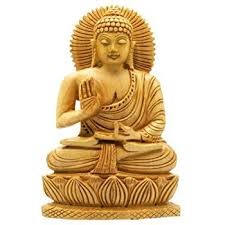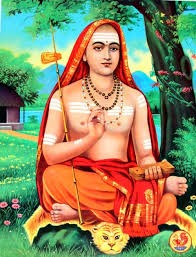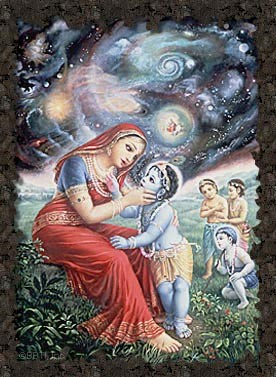Beyond Absolute Zero and Absolute One – What is Truth? Very few blessed souls ask this question. Truth by nature is invariant to space, time, religion and culture. The search for Truth has led seekers to describe it many ways. As per Bhagavad Gita, understanding the Truth means understanding who God is, who I am, what nature is, what time is and what one’s duty is. In this article, I will dwell on Budhism (Absolute Zero), Impersonalism (Absolute One) and Vaisnavism (Absolute Person) in philosophical terms.
Table of Contents
How to Collapse the Notion of I and Mine

All vedic schools follow almost the same line of reasoning to understand what I am NOT. One perceives and experiences this world as and when senses come in contact with sense objects. Such sense contacts bring in attachments for the senses objects – with that sense of attachment follows lust, anger, loss of intelligence and sometimes complete annihilation.
Bg 2.62 — While contemplating the objects of the senses, a person develops attachment for them, and from such attachment lust develops, and from lust anger arises.
With the mis-identification of oneself with sense objects, one falls prey to the idea that something belongs to him – he belives that the object of perception is his property. Thus the sense of ‘I’ comes based on the sense of ‘MINE’. One can obseve that this ‘I’ness is based on my family, my country, my education, my gender and so forth. This false possessiveness arises fear, lust, greed, illusion, envy and pride in him according to time, place and circumstance.
This behaviour is equally true for a woodcutter as much as for a king. Thus any spiritual tradition advocates the renunciation of one’s possession which will naturally collapse the idea pseudo ‘I’ – a neutral state from where one can fearlessly ask ‘who I am’. This is minimally require for one to be called a genuine seeker of Truth.
The World of Suffering and Buddhism
Lord Buddha started with a premise that ‘The world is full of suffering’ and the same premise is there in the Bhagavad Gita that this world is the place of suffering and temporariness – BG 8.15 ‘Dukhalayam Asasvatam’.

Bg 8.15 — After attaining Me, the great souls, who are yogīs in devotion, never return to this temporary world, which is full of miseries, because they have attained the highest perfection.
We know that that the soul is eternally full of joy and knowledge. So, what is this suffering actually? Suffering is there because the soul assumes a false or artificial state. We all are condition to assume such false states – ’Í am beautiful’, ’I am rich’, ’I am intelligent’, ’I am humiliated’ and so forth. A condition jiva situate in any of these un-natural states is subjected to a constant fear. Whichever state you may go or you try to situate yourself in, that state will always create a fear within you.
A professor may fear his intellectual ability being question, a rickshaw puller may fear for his inability to feed his family members sumptuously, a rich man may fear the depletion of his wealth, and a celebrity may fear for his brand value. By simple introspection, one can recognize that every state is infect with fear. As stated in Srimad Bhagavatam

SB 3.25.42 — It is because of My supremacy that the wind blows, out of fear of Me; the sun shines out of fear of Me, and the lord of the clouds, Indra, sends forth showers out of fear of Me. Fire burns out of fear of Me, and death goes about taking its toll out of fear of Me.
By analysis, one recognizes that he is not his thought, he is not his intellect, he is not his wealth, he is not his beauty, nor is he his possessions. Because of the mis-identification of the self with such externals – thought, wealth, beauty and so on – fear catches. And fear is the ultimate form of the suffering in this world.
So Lord Buddha taught His followers to purge out all forms of thoughts through meditation. In this logic, the totality of existence must be free from all kinds of thought processes and the consequent sufferings. Given that ‘I’ness comes from that what is ‘Mine’, a Buddhist seriously detaches himself from everything that he may consider his. By annihilating ‘Mine’, the concept ‘I’ also collapses. Thus one enters the region of void. When a practitioner aligns himself to such a concept, he identifies himself to that sense of complete silence which is famously known as Absolute Zero. This is what is termed as NIRVANA by Lord Buddha – a state where a jiva is completely relieved of material miseries, particularly in the form of lust, greed, anger, pride and illusion.
What is the limitation of Buddhism then? In the process of annihilating all our thought process, we are transport to a state of No Experience – the complete silence. One does not associate with sound, form, touch, smell and taste. Absolute zero means it is a state of complete silence – Nirvana. In Buddhism, Nirvana means reaching the state of absolute zero, that means you are not affect by any form of experiences. A sincere Buddhists must pursue the complete annihilation of his existence – no activity. For a Buddhist, there is no existence. From no existence, comes existence – that’s not very sound argument. If Truth is void, what is the necessity of variegated nature of existence? How does experience manifest from Zero?
Adi Shankara and Advaita-vada
From having no experience to having an eternal experience, the advaita philosophy of Adi Shankaracharya took us a step forward. ‘aham brahma asmi’ – I eternally exist as a pure state. It also rejects the idea that the infinity has a form and a personality. By severe practice of austerity and study of Upanisads, a jnani recognizes (can experience like Raman Maharsi and others) that he still exists even in death. But because, the process takes exclusive shelter of intellectual speculation, one falsely identifies himself with oneness of God – I am one with God. ‘tattvam asi’ – is wrongly interpret as on perfection one becomes GOD

Jnana yoga and impersonalists (jnana yogis) have been there since time immemorial – Shukadeva Gosvami, Kumaras, Durvasha and others were great impersonalists before accepting the path of bhakti. In that form, impersonalists realize the Brahman aspect of Truth. That Brahman eternally exists and free from birth, death, old age and disease is the significant contributions to the idea of Truth by the jnanis. These jnanis are referred in vedic literature as Brahmavadi. However, the followers of Shankaracharya are called as Mayavada by Sri Chaitanya Mahaprabhu as they declare themselves to be God upon attaining so called perfection. How can God be covered by illusion? Although fallacious, Adi Shankaracharya propagated this Mayadava philosophy to establish the path of Veda. Even Brahman aspect is very limiting as one has to do the explaining – form comes from form-less, illusion being variegated appears to be superior to Brahman and so forth.
A dhyana yogi goes a step further. Through intense meditation, he recognizes that the supersoul is source of all kinds of information or knowldege that the self perceives (SB 2.2.35).
SB 2.2.35 — The Personality of Godhead Lord Śrī Kṛṣṇa is in every living being along with the individual soul. And this fact is perceive and hypothesized in our acts of seeing and taking help from the intelligence.
At the state of NIRVANA, they ask this question: ‘Wait a moment – I am different from this body, I have no connection with this material elements, who then brings me all these information?’ Thus a yogi gets enlightened to see two birds in the same body by following the very strict methods of astanga yoga.
samāne vṛkṣe puruṣo nimagno anīśayā śocati muhyamānaḥ /
juṣṭaṃ yadā paśyaty anyam īśaṃ asya mahimānam iti vītaśokaḥ // 4.7 //Svetasvatara Upanisad
On the same tree, the individual soul, deluded by forgetfulness of his identity as the servant of Lord Krishna, bewildered by his ego, grieves and is sad. But when he recognizes the other as the Lord worshipped by all and His glory, he becomes free from grief.
Absolute Person and Vaisnavism
Absolute Truth is ultimately a person is the highest realization and is the core premise on which Vaisnavism is practiced. A pure devotee who is fully surrendered to that Absolute loving person is blessed to realize this highest vedantic conclusion and hence engages himself in the loving devotional service to please that Supreme Person. Lord Krishna happens to be that Absolute Truth and all authorities – Narada, Brhma, Shiva, Vyasa, Adi Shankaracharya, Sri Chaitanya – recognize Him in that way. Lord Krishna is infinite and thus inconceivable. So also His personality is inconceivable. He can manifest simultaneously at all points of space and time – both material sky and spiritual sky. Nobody can know Him but He can graciously reveal Himself as a relation to a pure Jiva as his father, mother, teacher, master, servant and so forth.
In the introduction to Bhagavad Gita AS IT IS, Srila Prabhupada categorically says that both jnanis and yogis are not eligible to receive Lord Krishna’s message as it is. Lord Krishna emphatically declares that Arjuna is HIS friend and His devotee and thus He is speaking this most confidential knowledge (the science of relationship with Krishna) to him (Arjuna). Thus Arjuna became a bonafide acharya. A pure devotee or a revealed acharya such as Srila Prabhupada can easily guide us to the platform of our real svarupa that we are eternal servant of Krsna. Before a devotee sadhaka can claim that he is an eternal servant of Krsna, he also needs to annihilate his bodily concept of life. He needs to be completely free from all vices such as lust and greed.
Then only he can see everything belongs to Krsna and he is simply a servitor. Interestingly this platform is achieve simply performing devotioinal services 24 hours a day without becoming mental about it. While Buddhists, jnanis and yogies perform severe austerities to just come to the platform of no connection with this material world, a sadhaka devotee acts on the same axioms as that of the Absolute Truth without even understanding this subject. Everythings is Krishna’s and hence everything must be use in His service. That is why the grace of Sri Sri Guru and Krsna are supremely effulgent as all conditioned souls can understand this supremely confidential knowledge with this grace. Srila Prabhupada writes in the purport on BG 3.42:
‘Lust is reserve within body but it is given vent through senses. However these outlets are not in use when one acts in Krsna Consciousness. In Krsna Consciousness the soul makes direct connection with the Supreme Personality of Godhead. BG 3.42 Purport’
As Srila Prabhupada further writes in the purport of BG 4:25:
A fruitive worker sacrifices his material possessions to satisfy demigods for greater sense enjoyments. An impersonalist sacrifices his identity to merge with the Supreme. While a Krsna conscious person sacrifices everything for the pleasure of Krsna without losing his individual existence.
It is very important to note that a sadhaka needs to sacrifice everthing – time, sleep, energy, activity, body – for the pleasure of Krsna. This is the same message that Lord Kapila gave to mother Devahuti that one needs to perform serious devotional service in order to get rid of material encagement and to get back to one’s original Svarupa.
In the purport of BG 5.7 Srila Prabhupada writes:
A devotee does not like to hear anything except topics relating Krsna.
Thus a sadhaka devotee attains his spiritual svarupa by performing 24 hours devotional service per day starting with the chanting of Hare Krsna Mahamantra. This process ‘I and MINE’ do not exist in the axioms of devotional practices so also they do not exist in the state of perfection.
In Absolute Person Exists Absolute Zero and Absolute One
In Absolute Zero, there is no existence and hence there is no need for God in this conception. Even this brahmananda state has no activity. In Absolute Person, the pure existence is a person having unlimited diversity. Sound, touch, form, taste and smell have divine existence. This unlimited and diverse person has unlimited relationships with tiny souls – thus exhibiting His divine opulence which a fully surrendered devotee can realize and relish the nectar of transcendental mellows while rendering loving devotional service.

It becomes very easy to explain the diversity of this ephemeral existence by accepting that Absolute Truth is a personality and His inconceivable personality includes within Him His dwelling place, unlimited devotees, kalpatarus, kamadhenus, Yamuna and other rivers, Govardhana and other hills, and many other opulences beyond our experiences and imaginations. This material world is just a reflection of that spiritual world. There is spiritual sound that is why we have material sound. There are spiritual forms that is why we have here material forms. It is Lord Krishna’s internal potency that gives rise to infinite spiritual planets while He manifests infinite material universes through His external potency.
Lord Krishna is one without a second, but when He desires to celebrate His own opulence, He becomes Many. That is His inconceivable personality. We can hear it and appreciate it but we can not conceive this inconceivable personality. We can not understand how does He manifest unlimited worlds with unlimited variegated-ness so effortlessly. His inconceivable persona includes the totality of existence. Hence He is Absolute ONE. Although there are varieties of activities in Him, still He does not act. He is Prashanta – complete silence. In this sense, He is also Absolute Zero. Hence Buddhists and Impersonalists must take interest in the science of Krishna Consciousness so that they can properly understand what is Absolute Zero and what is Absolute One. Lets take joy in Krishna consciousness and relish the philosophical beauty of Krishna concept of infinity.
